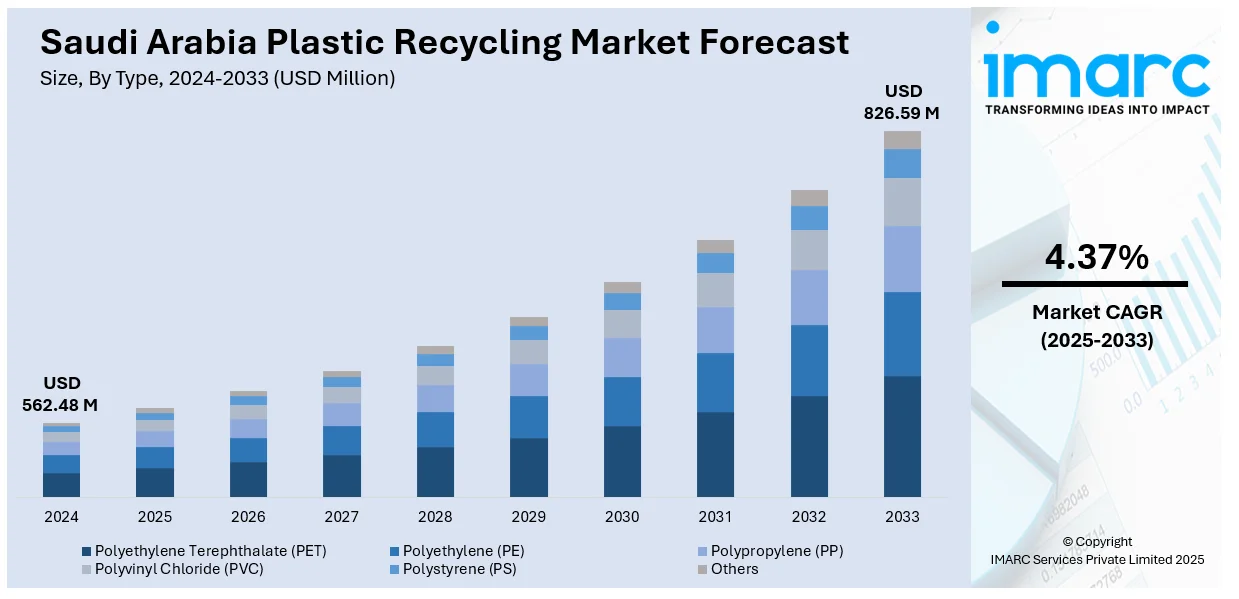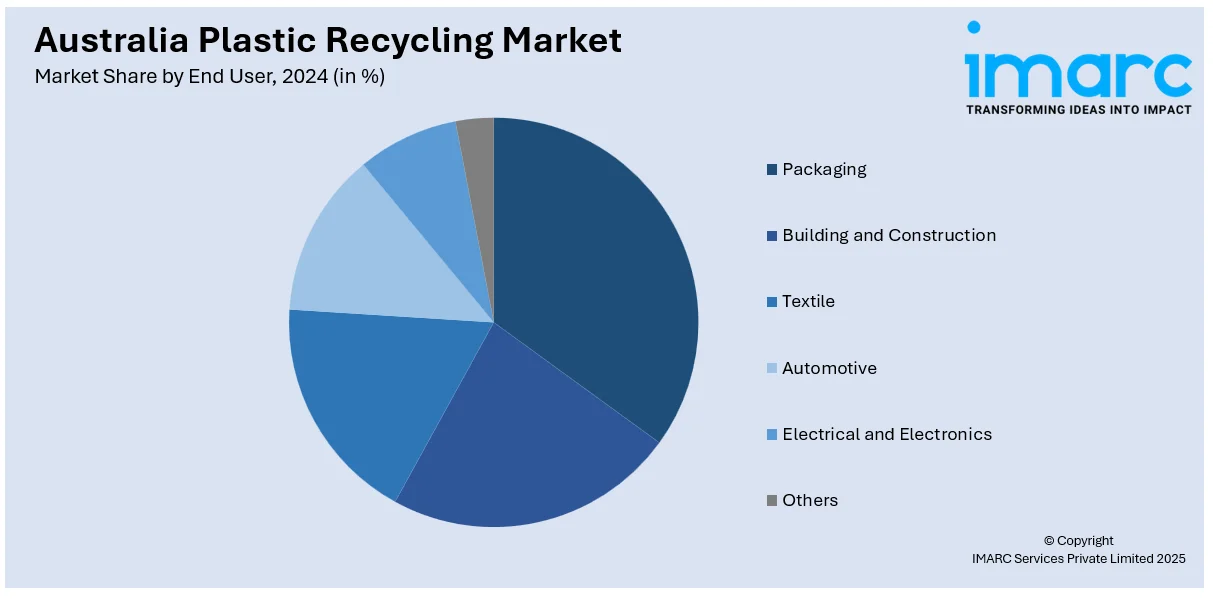
Saudi Arabia Plastic Recycling Market Size, Share, Trends and Forecast by Type, Source, End User, and Region, 2025-2033
Saudi Arabia Plastic Recycling Market Overview:
The Saudi Arabia plastic recycling market size reached USD 562.48 Million in 2024. Looking forward, IMARC Group expects the market to reach USD 826.59 Million by 2033, exhibiting a growth rate (CAGR) of 4.37% during 2025-2033. The market is expanding due to sustainability goals under Vision 2030, increasing industrial plastic waste, and growing awareness about environmental impact. Government support and technological advancements in recycling methods are further accelerating progress. Despite infrastructure challenges, strong regulatory frameworks and investments continue to strengthen the sector, positively influencing the Saudi Arabia plastic recycling market share.
|
Report Attribute
|
Key Statistics
|
|---|---|
|
Base Year
|
2024 |
|
Forecast Years
|
2025-2033
|
|
Historical Years
|
2019-2024
|
| Market Size in 2024 | USD 562.48 Million |
| Market Forecast in 2033 | USD 826.59 Million |
| Market Growth Rate 2025-2033 | 4.37% |
Saudi Arabia Plastic Recycling Market Trends:
Technological Advancements in Recycling Processes
Technological advancements are revolutionizing the plastic recycling industry in Saudi Arabia. Innovations in chemical recycling, where plastics are broken down into their chemical components for reuse, enable the processing of complex waste materials. The development of advanced recycling technologies allows for higher-quality recycled products and greater efficiency in processing. Advanced technologies decrease the requirement for virgin materials, which supports current sustainability directions worldwide. Saudi Arabia boosts its recycling techniques through research investments, which will drive the growth of its plastic recycling industry. Furthermore, adopting advanced technologies helps reduce the cost of recycling and enhances the circular economy. For instance, in April 2024, chemical industry expert SABIC announced the successful launch of Saudi Arabia's first circular packaging project as part of its TRUCIRCLE initiative, which aims to hasten the adoption of a circular plastic economy. In their Oat Arabic Bread, FONTE, a significant participant in the Kingdom of Saudi Arabia's (KSA) bakery sector, has launched bread bags produced with SABIC's certified circular polyethylene (PE).

Government Policies and Vision 2030 Initiatives
The Saudi Arabian government’s Vision 2030 outlines ambitious goals for sustainability and waste management. As part of this vision, the National Transformation Program (NTP) focuses on reducing reliance on oil and enhancing environmental practices. The government’s growing emphasis on recycling and circular economies has led to the establishment of frameworks that incentivize investments in plastic recycling technologies. These policies push industries to adopt recycling practices, fostering the development of new infrastructure. The government also partners with private companies to improve waste management, positioning plastic recycling as a key focus area for sustainability, which drives the Saudi Arabia plastic recycling market growth.
Public Awareness and Environmental Consciousness
Rising public awareness of environmental issues is accelerating the demand for sustainable practices in Saudi Arabia. Growing concerns about plastic waste and its environmental impact are prompting consumers to seek eco-friendly products, including those made from recycled materials. Media coverage and educational campaigns have encouraged individuals and businesses to consider the ecological footprint of their activities. As consumers become more environmentally conscious, there is greater pressure on industries to adopt recycling initiatives. This shift in consumer behavior is a critical driver for the plastic recycling market, as businesses respond to the demand for recycled products and sustainable waste management practices.
Saudi Arabia Plastic Recycling Market Segmentation:
IMARC Group provides an analysis of the key trends in each segment of the market, along with forecasts at the country and regional levels for 2025-2033. Our report has categorized the market based on type, source, and end user.
Type Insights:
- Polyethylene Terephthalate (PET)
- Polyethylene (PE)
- Polypropylene (PP)
- Polyvinyl Chloride (PVC)
- Polystyrene (PS)
- Others
The report has provided a detailed breakup and analysis of the market based on the type. This includes polyethylene terephthalate (PET), polyethylene (PE), polypropylene (PP), Polyvinyl chloride (PVC), polystyrene (PS), and others.
Source Insights:
- Bottles
- Films
- Fibers
- Foams
- Others
A detailed breakup and analysis of the market based on the source have also been provided in the report. This includes bottles, films, fibers, foams, and others.
End User Insights:

- Packaging
- Building and Construction
- Textile
- Automotive
- Electrical and Electronics
- Others
A detailed breakup and analysis of the market based on the end user have also been provided in the report. This includes packaging, building and construction, textile, automotive, electrical and electronics, and others.
Regional Insights:
- Northern and Central Region
- Western Region
- Eastern Region
- Southern Region
The report has also provided a comprehensive analysis of all the major regional markets, which include the Northern and Central Region, Western Region, Eastern Region, and Southern Region.
Competitive Landscape:
The market research report has also provided a comprehensive analysis of the competitive landscape. Competitive analysis such as market structure, key player positioning, top winning strategies, competitive dashboard, and company evaluation quadrant has been covered in the report. Also, detailed profiles of all major companies have been provided.
Saudi Arabia Plastic Recycling Market News:
- In July 2024, Saudi Arabia started a plastic waste management project that would process around 3 million tons of plastic garbage yearly to create refuse-derived fuels to meet its environmental sustainability goals, reduce pollution, and safeguard natural resources.
- In December 2023, the Saudi Investment Recycling Company (SIRC), a fully owned subsidiary of the Public Investment Fund (PIF) of Saudi Arabia, and the Alliance to End Plastic Waste (the “Alliance”) signed a Memorandum of Understanding (MoU) in a significant move to address plastic waste in the Kingdom of Saudi Arabia (KSA). This collaboration is strategically in line with KSA's goals to build a strong Saudi circular economy and divert 94% of waste from landfills by 2035. This collaboration's main goal is to investigate efficient waste management options in Saudi Arabia, with a focus on the problems caused by municipal solid waste (MSW), and more especially, plastics.
Saudi Arabia Plastic Recycling Market Report Coverage:
| Report Features | Details |
|---|---|
| Base Year of the Analysis | 2024 |
| Historical Period | 2019-2024 |
| Forecast Period | 2025-2033 |
| Units | Million USD |
| Scope of the Report | Exploration of Historical Trends and Market Outlook, Industry Catalysts and Challenges, Segment-Wise Historical and Future Market Assessment:
|
| Types Covered | Polyethylene Terephthalate (PET), Polyethylene (PE), Polypropylene (PP), Polyvinyl Chloride (PVC), Polystyrene (PS), Others |
| Sources Covered | Bottles, Films, Fibers, Foams, Others |
| End Users Covered | Packaging, Building and Construction, Textile, Automotive, Electrical and Electronics, Others |
| Regions Covered | Northern and Central Region, Western Region, Eastern Region, Southern Region |
| Customization Scope | 10% Free Customization |
| Post-Sale Analyst Support | 10-12 Weeks |
| Delivery Format | PDF and Excel through Email (We can also provide the editable version of the report in PPT/Word format on special request) |
Key Questions Answered in This Report:
- How has the Saudi Arabia plastic recycling market performed so far and how will it perform in the coming years?
- What is the breakup of the Saudi Arabia plastic recycling market on the basis of type?
- What is the breakup of the Saudi Arabia plastic recycling market on the basis of source?
- What is the breakup of the Saudi Arabia plastic recycling market on the basis of end user?
- What is the breakup of the Saudi Arabia plastic recycling market on the basis of region?
- What are the various stages in the value chain of the Saudi Arabia plastic recycling market?
- What are the key driving factors and challenges in the Saudi Arabia plastic recycling market?
- What is the structure of the Saudi Arabia plastic recycling market and who are the key players?
- What is the degree of competition in the Saudi Arabia plastic recycling market?
Key Benefits for Stakeholders:
- IMARC’s industry report offers a comprehensive quantitative analysis of various market segments, historical and current market trends, market forecasts, and dynamics of the Saudi Arabia plastic recycling market from 2019-2033.
- The research report provides the latest information on the market drivers, challenges, and opportunities in the Saudi Arabia plastic recycling market.
- Porter's five forces analysis assist stakeholders in assessing the impact of new entrants, competitive rivalry, supplier power, buyer power, and the threat of substitution. It helps stakeholders to analyze the level of competition within the Saudi Arabia plastic recycling industry and its attractiveness.
- Competitive landscape allows stakeholders to understand their competitive environment and provides an insight into the current positions of key players in the market.
Need more help?
- Speak to our experienced analysts for insights on the current market scenarios.
- Include additional segments and countries to customize the report as per your requirement.
- Gain an unparalleled competitive advantage in your domain by understanding how to utilize the report and positively impacting your operations and revenue.
- For further assistance, please connect with our analysts.
 Request Customization
Request Customization
 Speak to an Analyst
Speak to an Analyst
 Request Brochure
Request Brochure
 Inquire Before Buying
Inquire Before Buying




.webp)




.webp)












